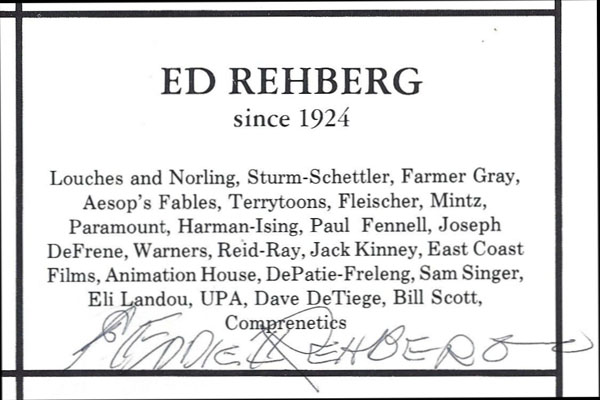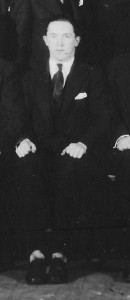
Edwin Wesley Rehberg’s career in animation was mostly unremarkable, having a fairly long list of credits as a journeyman animator and director. However, he does deserve a small place in animation history for his role in the ill-fated 1947 Terrytoons strike and for starting two early movie and TV commercial studios; he admitted his latter efforts were deservedly overshadowed by such rivals as Shamus Culhane Productions and Tempo Films, who helped convince a number of Fortune 500 companies to advertise on TV for the first time. I had interviewed before my Golden Awards video encounter, in 1981, for my history of animation unions. On a personal level, he and Al Eugster were classmates of my father, Joe Deneroff, at Cooper Union (class of 1932) and were likely responsible for him getting into animation. As his career after the Terrytoons strike as animator and director can easily be traced on IMDB, I will focus here on his work in theatrical films and early TV commercials.
Ed noted he was part of the first group of students to attend New York’s first junior high school, which enabled him to skip a grade, and then got into the prestigious Stuyvesant High School; but after his junior year there, at age 14, he got into Cooper Union, where he attended night classes, as he worked days as a runner for a bank. Eugster, who was probably then working at Pat Sullivan’s, Rehberg recalled, “was always very well dressed and reasonably affluent from the way I was living. So, I asked him what he did. He told me he was in the animation business. So, that sounded pretty good. And I knew [animator] Tom Bonfiglio, too. And Tom said, ‘Hey, it’s a way to make a living; why don’t you get into it instead of working in a bank?,” which he did.His first job in animation was “punching paper” at Loucks & Norling, which did theatrical commercials and training films; this was 1924, when he was about 15 years old — Rehberg, I should note, always had a hard time recalling dates; however, he did note that several future Disney artists, such as director Jack King, also worked there. However, Rehberg’s gig lasted only a month or two, as the studio shut down for awhile and he was forced to scrounge for work. Rehberg eventually found employment as a painter and inker at Aesop Fables/Van Beuren, about the time Paul Terry left; and like others at the time, he supplemented his income by washing cels. The animators there became his heroes and he remembers Mannie Davis with affection. Around 1933, he moved to Fleischer (who paid him more) as an inker and later became an inbetweener.
He was subsequently laid off when the studio ran into some financial problems; Cy Young, the future Disney special effects animation wizard, then asked Rehberg and his wife to join him and his wife on a road trip to California. In L.A., he got a job as an assistant animator at Mintz after bumping into Rudy Zamora on the street. It was the time Mintz was making Scrappy cartoons and Color Rhapsodies. Rehberg tells of the time he dropped into Schlesinger’s and spoke to the production manager there, who offered him a job as a director. “I didn’t have the audacity that I acquired later,” he said, “and he just floored me. And I said, ‘Well, I don’t think I’d qualify for that kind of job.’ I just passed it up, which [was] kind of awful. Anyway, in relation to that, the directors there [only] got $45.00 a week.” (Schlesinger’s was notorious for paying low wages, especially for inbetweeners just starting out.)
When he heard that Fleischer was recruiting for Miami in 1938, Rehberg was able to go from an assistant animator to animator, and more than triple his salary. There he worked on the Stone Age cartoons under Dave Tendlar and Gulliver’s Travels. After losing his job in Fleischer’s large-scale layoffs in early 1940, he went back to New York; there he eventually got work at Terrytoons as a story artist (briefly) and animator. He then developed tuberculosis, which in those days was often fatal; but after three years, he was able to return to work, though Terry was initially reluctant to take him back; and when he did, it was with a cut in salary. After this he became active in the Screen Cartoonists Guild and a a leader of the eight-month Terrytoons strike. The strike’s failure made it difficult for him (and others) to get work, so almost out of necessity he formed two small studios, East Coast Films and Animation House, to do theatrical and TV commercials which he talks about a lot in the video. Later on, he also claims to have been a director on the New York Institute of Technology’s Tubby the Tuba, though he is apparently uncredited.
As a reminder, this and other video interviews took place on Friday evening, January 20, 1984, at Sorrentino’s Restaurant, in Toluca Lake, during the Motion Picture Screen Cartoonists’ first Golden Awards Banquet. For more details on the event, check out my first post in this series here.
Next week: Chuck Couch.



 Harvey Deneroff is an independent film and animation historian based in Los Angeles specializing in labor history. The founder and past president of the Society for Animation Studies, he was also the first editor of Animation Magazine and AWN.com. Harvey also blogs at deneroff.com/blog.
Harvey Deneroff is an independent film and animation historian based in Los Angeles specializing in labor history. The founder and past president of the Society for Animation Studies, he was also the first editor of Animation Magazine and AWN.com. Harvey also blogs at deneroff.com/blog.




































































The cartoon link with this article is from the King Features era; is this specifically one that Rehberg did animation on? I ask, because it is mentioned that he worked at the Fleischer Studios for a short time, doing the CAVE MAN cartoons.
Yes. This one, “Lighthouse Keeping”, has story, layout and animation direction – three separate credits – by Ed Rehberg,
I’m enjoying this series on some of the animation world’s lesser known personalities. Very interesting. That said, every time I see one of those King Features made-for-TV Popeye cartoons, it reminds me how much I hate them.